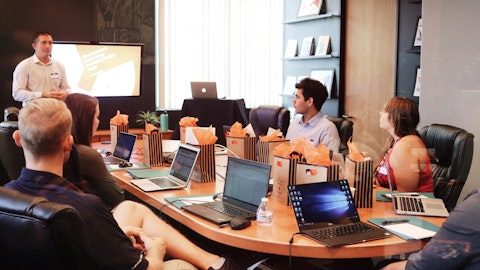Nu Holdings Ltd. (NYSE:NU) Q4 2022 Earnings Call Transcript February 14, 2023
Operator: Good afternoon, ladies and gentlemen. Welcome to Nu Holdings Conference Call to Discuss the Results for the Fourth Quarter of 2022. A slide presentation is accompanying today’s webcast, which is available in Nu’s Investors Relations website, www.investor.nu in English and www.investidores.nu in Portuguese. This conference is being recorded, and the replay can also be accessed on the Company’s IR website. This call is also available in Portuguese. To access it, press the globe icon on the lower right side of your Zoom screen and then choose to enter the Portuguese room. After that, select mute original audio. Please be advised that all participants will be in listen-only mode. You may submit online questions at any time today, using the Q&A box on the webcast. I would now like to turn the call over to Mr. Jorg Friedemann, Investor Relations Officer at Nu Holdings. Mr. Friedemann, you may proceed.
Jorg Friedemann: Thank you very much operator. And thank you all for joining our earnings call today. If you have not seen our earnings release, a copy is posted in the Results Center section of our Investor Relations website. With me on today’s call are David Velez, our Founder, Chief Executive Officer and Chairman, Youssef Lahrech, our President and Chief Operating Officer, and Guilherme Lago, our Chief Financial Officer. Additionally, Jag Duggal, our Chief Product Officer, will join us for the Q&A session of the call. Throughout this conference call, we will be presenting non-IFRS financial information, including adjusted net income. These are important financial measures for the Company, but are not financial measures as defined by IFRS.
Reconciliations of the Company’s non-IFRS financial information to the IFRS financial information are available in our earnings press release. Unless noted otherwise, all growth rates are on a year-on-year FX neutral basis. I would also like to remind everyone that today’s discussion might include forward-looking statements, which are not guarantees of future performance, and therefore, you should not put undue reliance on them. These statements are subject to numerous risks and uncertainties and could cause actual results to differ materially from the Company’s expectations. Please refer to the forward-looking statements disclosure in the Company’s earnings press release. Today, our Founder and CEO, David Vélez, will discuss the main highlights of our fourth quarter 2022 results and some of the opportunities ahead.
Subsequently, Guilherme Lago, our CFO; and Youssef Lahrech, our President and COO, will take you through our financial and operating performance for the quarter. After which time, we will be happy to take your questions. Now I’d like to turn the call over to David. David, please go ahead.
David Velez: Thank you, Jorg. Hello, everyone. Thank you for being with us today. Once again, I am happy to share that Nu posted another record quarter, showing continued growth across all our metrics, including meaningful increase in profitability. We will also be disclosing numbers for Nu Brazil specifically today, which we think show a very exciting picture. We welcome more than 4 million customers to our platform this quarter, and we now have close to 75 million clients across our three geos, posting a growth of 38% year-on-year. We’re now the fifth largest financial institution in Brazil, and the sixth largest financial institution in Latin America in terms of number of customers. Let’s now dive into the main operating highlights of the quarter and of the year.
During the fourth quarter, our revenue amounted to almost $1.5 billion, growing 112% year-over-year. The triple-digit expansion in revenues is the compounded effect of the strong expansion of our active customer base in Brazil with our ability to cross-sell products and faster client engagement. Nu also expanded gross profit by 137% year-over-year to $578.3 million in the fourth quarter of 2022. The significant expansion of our gross profit margin, which reached 40% this quarter, up from 36% in the fourth quarter of 2021, reinforce the operational leverage capacity of our business and the strong execution of our team. In 2022, we succeeded both in terms of pricing, adequately credit products amidst adverse conditions and adapting our funding cost to deal with much higher-than-expected interest rates.
As a result, Nu Holdings delivered an adjusted net income of $113.8 million in the fourth quarter of 2022, up from $3.2 million in the fourth quarter of 2021. The Brazilian operations highlighted in the right side of the slide continue to mature and contribute meaningfully to these results with 93% of our revenues generated by this year. Adjusted profit for the Brazilian operations reached $157.7 million in Q4 of 2022, up from a loss of $3.8 million during the fourth quarter of 2021. Our progress in Brazil illustrates our business model is able to start generating meaningful profits, while growing revenue over 100%. The beginnings of Nu were based on the unbundling of financial services back in 2013. Now our most important business opportunities rest on the rebundling of financial services by building a diversified multi-product, multi-segment and multi-country portfolio of businesses.
As you can see on this slide, even our adjacent businesses already achieved a notable figure of customers, attesting the Company’s cross-sell capacity. Despite the growing scale of our core products, Nu is still in the early days of its product development life cycle. That said, the size of the inflection of the score for our products are already clear. This slide is meant to show two things. First, the in which we developed in product has accelerated over time. Second, our product portfolio is well positioned to deliver multiple years of strong growth. While Nu accounts and credit cards have just reached the inflection points of their growth stages, most of our other products are at earlier stages of their life cycles, suggesting still high levels of up-sell and cross-sell potential for multiple sources and for years to come.
We will continue to expand our platform with disruptive products that further strengthen relationship with our customers and enable us to acquire increasing levels of customer principality and share of wallet across all demographic segments, where most of our launches in 2023 include the expansion of organic products in Brazil into secure lines such as public payroll and the launching of savings accounts in both Mexico and Colombia. Just as Nu is in the early days of its product development life cycle, it is also in the early days of its international expansion. Over the past decade, we have successfully expanded our operations in Brazil, having reached a customer base that represents 44% of the population of the country. It is inevitable that our customer growth in Brazil over the coming years will be lower than what we experienced over the last years.
Our growth in Brazil will progressively pivot from customer acquisition into customer monetization. Conversely, however, we’re still at the early stages of the customer acquisition life cycle in Mexico and Colombia, countries in which our penetrations are still low, but early signs of performance are extremely encouraging. Mexico and Colombia are Brazil are practically every single customer growth and engagement metric. They’re growing faster and showing NPS levels higher than dose of Brazil. In both of these countries, we have already become the top issuer of Nu credit cards. The stages of development for three geos are complementary and expected to provide Nu with very strong growth engines for years to come. To better showcase the earnings potential of our model, we want to spend a few minutes digging specifically into our Brazil business, which continues to show very strong top line traction and also meaningful bottom line profitability.
Over the past four years, we expanded our client base in Brazil by 11 having reached a penetration of 44% of the adult population of the country. 70% to 80% of the clients came to Nu through organic channels, mostly member to member, providing us with strong growth and one of the lowest customer acquisition costs among fintechs and incumbent banks globally. We have been successfully applying the same playbook in Mexico and Colombia. The compounding effect of customer growth and higher levels of customer monetization have resulted in strong top line in Brazil. In the fourth quarter of 2022, our Brazilian operations recorded $1.4 billion in revenue, 110% year-on-year growth and a gross profit margin of 44%. Adjusted net income grew progressively over the past quarters, reaching $158 million in the fourth quarter of 2022 for an annualized adjusted return on tangible equity of 58% and an annualized return on equity of 40%.
Although part of this number was positively impacted by the seasonal effects observed in the first quarter of the year, such as higher purchase volume and lower cost of funding, one can see that the profitability of our operations in Brazil has reached an inflection point and already positioning us among one of the financial institutions with the highest return on capital in the country. But we believe we’re still in the early stages of the development of the country with still significant upside in terms of both top line growth and operating leverage. Finally, this slide details the outcome of our strategy in Brazil and at the holding level. The viral expansion of our customer base, combined with our successful cross-selling and up-selling strategies have driven strong profitability in our Brazil business.
fourth quarter that is positively affected by seasonality, Nu Brazil posted a return on tangible equity of 25% and a return on equity of 15% for the full year of 2022 even considering the losses reported in the first quarter of the year. While 2022 was a challenging year micro wise and very critical for us as we build trust as a newly company, we could not be more proud of our 2022 results, which largely exceeded our internal expectations. The execution capability of the entire Nu team was very strong and we proved that it is possible to maintain an accelerated growth as we gain share in every product vertical and geography, while keeping credit delinquency in check, improving operating leverage and ultimately showing strong profitability. For this achievement, as important as they are, represent only the first steps of where we can deliver in the future.
Once our new geos mature and similarly to Brazil, scale further and start to compound the profitability potential that our model creates. With that, I would like to pass the floor to our CFO, Guilherme Lago, who will walk you through more details of our results. Thank you.
Guilherme Lago: Thanks, David, and good evening, everyone. To better frame the discussion around our year-end results, I would like to recap the three key elements of our simple and powerful value-generating strategy. Number one, continue to grow our customer base in the markets in which we operate, Brazil, Mexico and Colombia, and quickly converting new customers into active ones; two, expanding average revenue per active customer, or ARPAC, through both cross-sell and up-sell; and three, delivering growth while maintaining one of the lowest cost operating platforms in the industry. Our fourth quarter results show positive evolution in each one of these three pillars. Let’s start with the first pillar of our strategy, customer acquisition.
In the fourth quarter, we added 4.2 million and ended the year with 74.6 million customers, a 38% increase year-over-year. In Brazil, we are steadily adding between 1 million and 1.5 million customers per month, the vast majority of which will come from referrals, which lowers the acquisition cost and accelerates activation. In Mexico, we surpassed 3.2 million customers by the end of the quarter. As per the last available data for 2022, Nu’s market share in terms of new cards issued in the country approached 29%, while share of purchase volumes for credit cards already achieved 5%. Our strongest growth in relative terms was in Colombia, where our customer base reached nearly 600,000. In Colombia, Nu accounted for 38% of the number of Nu cards in 2022 as per the latest available information, with 2% market share in terms of purchase volumes for credit cards.
The second part of this pillar is activation, where we continue to drive higher levels in the fourth quarter. Our overall monthly activity rate reached 81.9%, 5.6 percentage points higher year-over-year and the 11th consecutive quarter of sequential increase. We are seeing positive and increasing momentum in activity in all of the three markets in which we operate despite their different stages on the S curve. Let’s move to the second pillar in our strategy, revenue generation. The three charts on this slide show a clear relationship. Let’s start with the chart on the left. We are very proud that as of the end of 2022, 58% of our active customers have chosen Nu as their primary banking account or PBA. This is the holy grail of the financial services business and the cornerstone of our model, for three simple reasons.
Number one, PBA customers generate ARPACs that are much higher than those of non-PBA customers. Number two, PBA customers present 90-day NPLs that are much lower than those of non-PBA customers. And three, PBA customers also have lower levels of price elasticity and adverse than those of non-PBA customers. The number of PBA customers underscores the development of the model that effectively engages and serves our customers with multiple products and throughout all stages of their life cycle. It begins with how we attract clients, which is through a powerful engine based on customer referrals. The more customers use Nu as its primary bank account, the greater the number of products they use and the higher the monthly ARPAC they generate. With every cohort, we have been able to accelerate the pace at which Nu becomes the primary bank account of our customers.

Photo by Cytonn Photography on Unsplash
We have also been able to accelerate the pace at which our customers use our products. These two factors compounds to speed up our pack for Nu accounts and also helping to push up the overall ARPAC of the Company. For the fourth quarter, our monthly ARPAC continued to increase and achieved $8.2 per month, pushed by both the increase in cross-selling and up-selling of our new cohorts and the moderation of our older cohorts, whose average ARPAC reached $23 per month. We can see in this slide that our monthly ARPAC continues to grow sequentially, expanding 37% year-over-year. The higher number of active clients combined with higher ARPAC prompt the sustained growth in our revenues. Revenue grew 112% year-over-year to $1.5 billion, another record high.
Our revenue in 2022 was nearly 3x higher than in 2021 and almost 7x higher than in 2020. Now turning to the cards business. We continue to experience strong growth with purchase volumes up 54% year-over-year to $24 billion. In 2022, purchase volumes reached $81 billion, an 85% increase over 2021, demonstrating the power of our product cross-sell, up-sell and customer engagement capabilities. Most of the purchase volumes continue to come from our older cohorts of customers, which span 3x to 4x as much per month as recent cohorts. While there is a difference from the outset between newer and older cohorts as shown chart on the right-hand side both show a clear upward trends of consumption over time. On average, credit card spend for a customer who has been with us for more than 24 months, triples.
We expect the substantial amount of clients we added in the last two years to increase their purchase volumes with our cards as their relationships with us continue to mature. Our consumer finance portfolio composed of credit card and personal loans reached $11 billion, a 62% expansion over year-end 2021. Our credit story has two tales. On the one hand, credit cards continue to grow strongly at 69% year-over-year as more clients are added to our ecosystem and our loan draw methodology plays out. On the other hand, we have been more cautious with the originations in the personal loan portfolio aligned with the higher risk of product. Originations and personal loans increased slightly and the overall book grew sequentially during the fourth quarter to $2 billion.
The base of growth has been lower than that of credit cards at 33% year-over-year. But with the ongoing performance of the book, we expect this to accelerate over the coming quarters. Now let’s review in more details, the evolution of our credit card portfolio and the originations of our personal loans. We continue to pursue our strategy of increasing the share of our credit card loans that earn interest, closing the gap as compared to the market. We have narrowed this gap by offering our customers interest-earning installment loans on their credit cards, which is of the fourth quarter surpassed market levels and represented 12% of our credit card loan book. We see attractive risk-adjusted rates of returns on this type of finance. It allows us to monetize our credit card business beyond simple fee generation and fulfill customer need.
At the same time, we have been intentional in not expanding our share of revolving receivables, which continues at 7% of our total receivables and once again widened the gap versus the market, whose revolving now accounts for 17% of total receivables. We base our origination of personal loans on the latest performance of our own cohorts, our assessment of risk going forward, including our judgment of the economic and credit environment. Last year, we increased the resilience with demand from our loan originations, and we have seen positive performance to date, leading to gradual increases in our origination volumes. We expect this trend to continue going forward as long as this positive performance track record persists. Indeed, we continue to see upside in our ability to drive growth in lending in a healthy and profitable manner.
We have substantial rich given the size of our customer base. We believe the risk assessment in our platform is best-in-class, allowing us to deliver superior products and experience to our customers. We also have strong capital base and an ample liquidity to increase our leverage. As market conditions improved and allow our credit risk appetite to increase, we should be able to deploy capital effectively and profitably. This strategy should be reinforced with the upcoming launch of secured lending. In July 2022, we launched Money Boxes, which are personalized investment tubes. We also started to remunerate deposits at 100% of the Brazilian interbank deposit rate, but retroactively and only for amounts that remain on deposit for more than 30 days.
Given their stage rollout, these two changes did not materially affect our funding cost in the third quarter. But in the fourth quarter, we started to see the full impact of these changes. In the fourth quarter of 2022, our cost of funding improved to an all-time low of 78% of the interbank deposit rates. This led our financial expenses to decline quarter-over-quarter. We are now starting to unlock the value of the strong liability franchise that has been built over the past years, and our deposit base continued to grow. Deposits increased 55% year-over-year to $16 billion. We have seen no material impact on the deployment of Money Boxes or the changes in remunerations on our deposits inflow. The success of this new strategy already has had an important effect on our profitability for the fourth quarter and should be recurring in the subsequent quarters.
The successful implementation of our Nu funding strategy, combined with the continued growth of our credit portfolio made a meaningful contribution to our results in the fourth quarter. This is most feasible in our net interest income or NII. Our NII reached $688 million this quarter, growing 30% quarter-over-quarter. The improvement in our cost of funding helped increase in our net interest margin, or NIM, 2.4 percentage points over the level of the third quarter to a record high of 13.5%. While we can attribute much of the recent gains in net interest margins to our Nu funding strategy, we expect this trend, respected seasonality, which is especially strong in the fourth quarter, to continue going forward based on three factors: number one, the growth in our credit portfolio, which should surpass that of our deposits; number two, the adequate pricing of our credit products as we continue to build underwriting resilience with pricing; and number three, the improved mix of our loan book, especially as we resume the growth of our personal loans over the coming quarters.
Let’s move to the third pillar in our overall strategy, maintaining a low cost to serve. We believe our platform is one of the most cost-effective in customers in the markets in which we operate. For the fourth quarter, our cost to serve amounted to $0.90 of the dollar. On a year-over-year comparison, our cost to serve did not grow. This achievement is even more impressive considering how much we evolved in terms of products per customers and PBAs. Over the same period, our ARPAC increased 37%, clearly illustrating the strong operating leverage of our business model. Looking ahead, as we said in past quarters, we expect our cost to serve to remain at or below the dollar level as the scale gives us significant operating leverage and bargaining power with our suppliers.
In terms of gross profit, we achieved $578 million, up 137% year-over-year, a significant acceleration versus the growth posted last quarter. This level of gross profit was the highest we have ever achieved. At the same time, our gross profit margin of 40%, four percentage points higher year-over-year accelerated the pace of recovery started in the third quarter. To illustrate how far we have come, our gross profit of $1.7 billion in 2022 is more than 2x higher than of 2021 and nearly 5x higher than of 2020. Operating leverage is a key element of our strategy. With the full benefits becoming increasingly clear as we advance product penetration and drive revenue growth. This is visible in our efficiency ratio, which improved for the fourth consecutive quarter to reach an all-time low at 47% or 41% excluding share-based compensation.
This is already comparable to the levels of efficiency of Latin American incumbent banks, but it is still far from the potential of our platform that continues to collect the benefits of scale. We expect our operating leverage to continue to be captured as our scale increases, although there might be seasonal variations affecting this number. In the fourth quarter, in particular, our platform benefited from stronger purchase volumes and deposit inflows. Now moving on to the bottom line, we posted another quarter of improving bottom line performance. In the fourth quarter of 2022, our adjusted net income and net income amounted to $114 million and $58 million, respectively. These results are encouraging as they serve to validate our strategy and our business model.
However, we reinforce that we look at our business with a view towards long-term value creation, which may require us to make additional investments in the short term to optimize our long-term opportunities, and we expect to continue managing the Company this way. We see this fourth quarter and the year of 2022 as a whole as evidence of our sustainable cost advantages. On cost to acquire, we added over 20 million customers during 2022 and presented one of the lowest customer acquisition costs among fintechs and banks globally. On cost to serve, we held it constant on an FX-neutral basis throughout the entire 2022, despite the inflationary pressures in the countries in which we operate and increasing levels of customer engagement. On cost of risk, we successfully managed the risk in our credit portfolio amid a very challenging backdrop and continue to outturn competitors when comparing apples-to-apples.
Youssef will provide more details on that shortly. On cost of funding, we began to unlock the potential of our deposit franchise, starting to close the negative gap, we had a guest incumbent banks and widening the positive gap we have against fintechs. As we go into 2023, we expect the trends from the fourth quarter to continue to gain traction. In particular, we emphasize our ability to develop and scale best-in-class products, expand internationally and at very low cost. Now, I would like to turn the call over to Youssef, our President and Chief Operating Officer, who will walk you through some of the highlights of our asset quality.
Youssef Lahrech: Thank you, Lago. Let me take you through some key indicators of asset quality and overall credit portfolio health for the fourth quarter of 2022. Let us start with overall NPL trends. Our early delinquency indicator, NPL 15 to 90, improved this quarter by 50 basis points, reaching 3.7%. This was driven by two many factors. Number one, the improvement in the credit performance of our personal loans portfolio in response to the management actions taken in Q2; and second, the favorable seasonality that takes place during the fourth quarter when early delinquencies usually trough. It is important to note that, that trough is usually accompanied by a rebound in early delinquency rates during the first quarter of each year.
90-plus NPL ratio increased from 4.7% to 5.2%, behaving in line with the expected stacking behavior of these buckets. I want to take this opportunity to reinforce that Nu has never sold delinquent loans, which otherwise would have had a purging effect, thereby artificially lowering delinquency rates. With respect to loan renegotiations, they remain at around 7% of our book, with approximately half of those coming from current and not pass new customers at the time of renegotiation. For the credit card portfolio, these six graphs show the time series of NPL by income and where the purple line represents Nu and the gray line represents the industry. As we already mentioned during previous calls, and as you can see on these updated charts, we continue to outperform the industry on a like-for-like basis.
For the lower income ends, our comparative advantage is even more pronounced. The gap for each continues to widen as you look at the trend over time, demonstrating that our competitive advantage in underwriting remains consistent and sustained. Just as in past quarters, provisions continue to grow, primarily driven by the growth in our portfolio. We front-load provisions when we originate loans based on the expected losses for the life of the credit in accordance with IFRS-9 expected loss methodology. This quarter, much of the expansion in our risk-adjusted NIM can be traced back to the improvement in our cost of funding. However, even after adjusting for that factor, we would still see risk-adjusted NIM stronger than that of the third quarter and even stronger compared to that of the fourth quarter of 2021.
Having shared these data and perspectives on credit and asset quality, let me now turn the call back to our Founder and CEO, David Velez, for his concluding remarks.
See also 15 Countries that Produce the Best Honey and 25 Largest Pizza Chains in the World.
Q&A Session
Follow Nuance Communications Inc. (NASDAQ:NUAN)
Follow Nuance Communications Inc. (NASDAQ:NUAN)
David Velez: Thanks, Youssef. It has now been a little over one year since our IPO. And despite much more adverse conditions than we could have anticipated, we are proud to have over delivered on our commitments to the market. Over 8,000 colleagues delivered these results through an unwavering focus on strong execution and I thank each and every one of them. Let me now close by summarizing some of the most important changes in environment. We adapted our strategy to deliver on what has been promised in what lies ahead of us for 2023. First, in late 2021, no one expected the sharp increase in policy rates that skyrocketed to almost 14% in Brazil. To mitigate this, we launched Money Boxes, and six months later, we lowered our cost of funding to 78% of the CDI from about 100%, while both deposits and Money Boxes continue to grow sequentially and strongly.
Second, with a tougher environment for asset quality in Brazil, we became more restrictive in originating personal loans, while repricing our products and building resilience within our portfolios. In parallel, we accelerated the launch of with the general launch of payroll lending in Brazil expected in the upcoming quarter. We’re confident that this is a disruptive solution for our customers, which will foster growth into different client segments, thus further rebalancing our credit book. Third, we doubled down on smart efficiency, moves to foster profitability and showcase the operating leverage of our model. One of these moves was the termination of the CSA, which will save the Company $7 million per year. But beyond that, it reinforces how committed Nu as a company is, to accelerate value creation for all of our shareholders.
Our efficiency ratio will continue to improve progressively over the coming years as we capture cost savings opportunities and reduce the rate of headcount growth going forward. Finally, in 2023, we will prioritize winning our first share of wallet in the market in Brazil, where there remains tremendous opportunity, growing our personal lending book both secure and unsecured and expediting the inflection of the growth model in users. Almost 2 million customers with monthly income of BRL12,000 are already clients have of Nu. But our share of wallet with them is currently approximately 10%. In 2023, we will also break into a secured lending market, positioning payroll loans as a core product to complement our personal lending product shelf and widen our growth opportunities in the country.
Last, but not least, 2023 will be the year in which we launch and deepen the penetration of in both Mexico and Colombia, which should accelerate the growth and sustainability of our platform in these countries. We will continue investing significantly in both countries as we think the potential price is very significant. We entered 2023 with a lot of strength and are excited to continue proving our model across products and geographies. We would like to take your questions now. Thank you very much.
Operator: We will now start the Q&A session for investors and analysts. I would now like to turn the call over to Mr. Jorg Friedemann, Investor Relations Officer.
Jorg Friedemann: Thank you, operator. And our first question comes from Jorge Kuri, Morgan Stanley.





